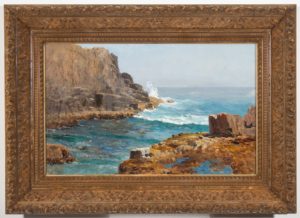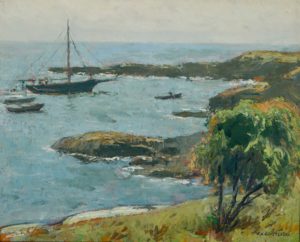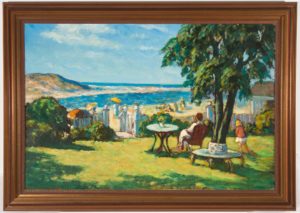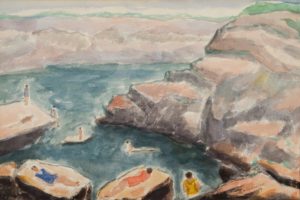April 21, 2020
by Ruth Greene-McNally, OMAA Curator and Collections Manager
From wherever you are standing, how far can you see? I will re-phrase the question: how far can you sea? Within OMAA’s exhibition, “The View from Narrow Cove” installation, you are never at a loss for a view of the sea and horizon.
Just as trees, mountains, the built environment, and cloud-cover can block a clear view of the horizon — dust, fog, and refracted light can hinder or aid visibility. Geometry tells us that the distance of the horizon, i.e., the farthest point the eye can see before the earth curves out beneath human view, depends on the height of the observer and various obstructions, weather-related or physical. For a 5’ 7” individual at ground level, a view of the horizon extends approximately 3 miles.

James Craig Nicholl (1847-1918)
Under Bald Head Cliff, ME
1903
Oil on canvas
13.5 x 21. 5 in.
#2018.8.1 Gift of Mr. & Mrs. Frank McMillan Wooten
Nicholl studied painting under the Dutch-American painter Mauritz de Haas, concentrating on New England coastal scenes. He exhibited his work at the Art Institute of Chicago, The National Academy of Design, and The Boston Art Club.

Clarence Chatterton (1880-1973)
Perkins Cove, Ogunquit
1918
Oil on board
16 x 20 in.
# 2012.73, Gift of Todd Poole in Memory of J.T.B.

Clarence Chatterton
Summer in Ogunquit
c. 1915
Oil on canvas, 24 x 36
Gift of Owen Wells, 2018
Walkowitz is perhaps best known for his watercolor studies of Isadora Duncan and laid claim to being the first to exhibit truly Modernist paintings in the United States. After 1909, Walkowitz became a central contributing exhibitor at Alfred Stieglitz’ 291 Gallery in Manhattan, and an active participant in the debate over modern art in America. He was an outspoken proponent of experimentation in the arts, as Modernism moved from avant-garde protest against established modes to an accepted cultural shift in American arts and letters.

Abe Walkowitz (1880-1965)
Bathers on Rocks
1910
Watercolor on paper
16 x 24 in.
#2015.1, Museum Purchase
The View From Narrow Cove: Bicentennial Oqunquit is made possible through the generous support of Sparhawk Oceanfront Resort and The Maine Bicentennial Commission.


